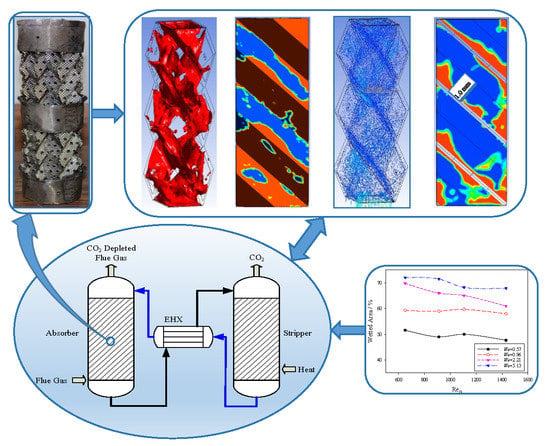CFD Modeling on Hydrodynamic Characteristics of Multiphase Counter-Current Flow in a Structured Packed Bed for Post-Combustion CO2 Capture
Abstract
:1. Introduction
2. Computational Model
2.1. Governing Equations
2.2. Geometry
2.3. Meshing
2.4. Turbulence Model
2.5. Boundary Conditions
3. Results and Discussion
3.1. Validation of Simulation Model
3.2. Liquid Distribution and Surface Wettability
3.3. Formation of Droplets
3.4. Film Thickness
4. Conclusions
Author Contributions
Funding
Conflicts of Interest
References
- Yu, H. Carbon capture and storage: A challenging approach for mitigation of global warming. Int. J. Clean Coal Energy 2013, 2, 23–24. [Google Scholar] [CrossRef]
- Thompson, J.G.; Combs, M.; Abad, K.; Bhatnagar, S.; Pelgen, J.; Beaudry, M.; Rochelle, G.; Hume, S.; Link, D.; Figueroa, J.; et al. Pilot testing of a heat integrated 0.7 MWe CO2 capture system with two-stage air-stripping: Emission. Int. J. Greenh. Gas Control 2017, 64, 267–275. [Google Scholar] [CrossRef]
- Yang, L.; Liu, F.; Song, Z.; Liu, K.; Saito, K. 3D Numerical Study of Multiphase Counter-Current Flow within a Packed Bed for Post Combustion Carbon Dioxide Capture. Energies 2018, 11, 1441. [Google Scholar] [CrossRef]
- Ranade, V.; Chaudhari, R.; Gunjal, P. Hydrodynamics and Flow Regimes. In Trickle Bed Reactors; Elsevier: Amsterdam, The Netherlands, 2011; Chapter 2; pp. 25–75. [Google Scholar]
- Haroun, Y.; Legendre, D.; Raynal, L. Direct numerical simulation of reactive absorption in gas–liquid flow on structured packing using interface capturing method. Chem. Eng. Sci. 2010, 65, 351–356. [Google Scholar] [CrossRef]
- Kim, J.; Pham, D.A.; Lim, Y.-I. Gas−liquid multiphase computational fluid dynamics (cfd) of amine absorption column with structured-packing for CO2 capture. Comput. Chem. Eng. 2016, 88, 39–49. [Google Scholar] [CrossRef]
- Saito, K.; Ito, A.; Nakamura, Y. Progress in Scale Modeling. In The International Symposia on Scale Modeling, ISSM VI (2009) and ISSM VII (2013); Springer: Berlin, Germany, 2013; Volume II. [Google Scholar]
- Pangarkar, K.; Schildhauer, T.; Ommen, J.; Nijenhuis, J.; Kapteijn, F.; Moulijn, J.A. Structured Packings for Multiphase Catalytic Reactors. Ind. Eng. Chem. Res. 2008, 47, 3720–3751. [Google Scholar] [CrossRef]
- Basden, M.; Eldridge, R.B.; Farone, J.; Feng, E.; Hussey, D.S.; Jacobson, D.L. Liquid holdup profiles in structured packing determined via neutron radiography. Ind. Eng. Chem. Res. 2013, 52, 17263–17269. [Google Scholar] [CrossRef]
- Guo, X.; Sun, Y.; Li, R.; Yang, F. Experimental investigations on temperature variation and inhomogeneity in a packed bed clc reactor of large particles and low aspect ratio. Chem. Eng. Sci. 2014, 107, 266–276. [Google Scholar] [CrossRef]
- Yeoh, G.; Tu, J. Computational Techniques for Multiphase Flows. Butterworth-Heinemann: Oxford, UK, 2010. [Google Scholar]
- Zhang, H. High Temperature Flow Solver for Aerothermodynamics Problems. Ph.D. Thesis, University of Kentukcy, Lexington, KY, USA, August 2015. [Google Scholar]
- Lopes, R.J.G.; Quinta-Ferreira, R.M. Cfd modelling of multiphase flow distribution in trickle beds. Chem. Eng. J. 2009, 147, 342–355. [Google Scholar] [CrossRef]
- Gunjal, P.; Kashid, M.; Ranade, V.; Chaudhari, R.V. Hydrodynamics of Trickle-Bed Reactors: Experiments and CFD Modeling. Ind. Eng. Chem. Res. 2005, 44, 6278–6294. [Google Scholar] [CrossRef]
- Wen, X.; Shu, Y.; Nandakumar, K.; Chuang, K.T. Predicting liquid flow profile in randomly packed beds from computer simulation. AIChE J. 2001, 47, 1770–1779. [Google Scholar] [CrossRef]
- Hoffmann, A.; Ausner, I.; Repke, J.; Wozny, G. Fluid dynamics in multiphase distillation processes in packed towers. Comput. Chem. Eng. 2005, 29, 1433–1437. [Google Scholar] [CrossRef]
- Yu, D.; Cao, D.; Li, Z.; Li, Q. Experimental and CFD studies on the effects ofsurface texture on liquid thickness, wetted areaand mass transfer in wave-like structured packings. Chem. Eng. Res. Des. 2018, 129, 170–181. [Google Scholar] [CrossRef]
- Olenberg, A.; Reschetnikb, W.; Kullmer, G.; Kenig, E.Y. Optimization of structured packings using twisted tape inserts. Chem. Eng. Res. Des. 2018, 132, 1–8. [Google Scholar] [CrossRef]
- Haroun, Y.; Raynal, L.; Alix, P. Prediction of effective area and liquid hold-up in structured packings by cfd. Chem. Eng. Res. Des. 2014, 92, 2247–2254. [Google Scholar] [CrossRef]
- Ding, H.; Li, J.; Xiang, W.; Liu, C. Cfd simulation and optimization of winpak-based modular catalytic structured packing. Ind. Eng. Chem. Res. 2015, 54, 2391–2403. [Google Scholar] [CrossRef]
- Fourati, M.; Roig, V.; Raynal, L. Liquid dispersion in packed columns: Experiments and numerical modeling. Chem. Eng. Sci. 2013, 100, 266–278. [Google Scholar] [CrossRef] [Green Version]
- Haroun, Y.; Raynal, L.; Legendre, D. Mass transfer and liquid hold-up determination in structured packing by cfd. Chem. Eng. Sci. 2012, 75, 342–348. [Google Scholar] [CrossRef] [Green Version]
- Ginzburg, I.; Wittum, G. Two-phase flows on interface refined grids modeled with vof, staggered finite volumes, and spline interpolants. J. Comput. Phys. 2001, 166, 302–335. [Google Scholar] [CrossRef]
- Renardy, Y.; Renardy, M. Prost: A parabolic reconstruction of surface tension for the volume-of-fluid method. J. Comput. Phys. 2002, 183, 400–421. [Google Scholar] [CrossRef]
- Zhang, C.; Zhang, W.; Lin, N.; Tang, Y.; Zhao, C.; Gu, J.; Lin, W.; Chen, X.; Qiu, A. A two-phase flow model coupling with volume of fluid and immersed boundary methods for free surface and moving structure problems. Ocean Eng. 2013, 74, 107–124. [Google Scholar] [CrossRef]
- Hirt, C.; Nichols, B. Volume of fluid (VOF) method for the dynamics of free boundaries. J. Comput. Phys. 1981, 39, 201–225. [Google Scholar] [CrossRef]
- Olsson, E.; Kreiss, G. A conservative level set method for two phase flow. J. Computat. Phys. 2005, 210, 225–246. [Google Scholar] [CrossRef]
- Olujić, Ž.; Seibert, A.; Fair, J. Influence of corrugation geometry on the performance of structured packings: An experimental study. Chem. Eng. Process. Process Intensif. 2000, 39, 335–342. [Google Scholar] [CrossRef]
- Cable, M. An Evaluation of Turbulence Models for the Numerical Study of Forced and Natural Convective Flow in Atria. Master’s Thesis, Queen’s University, Kingston, ON, Canada, May 2009. [Google Scholar]
- Stikkelman, R.; Teeuw, H.; Wesselingh, H.; de Graauw, J.; Olujic, Z. A study of gas and liquid distributions in structured packings. Chem. Eng. Technol. 1989, 12, 445–449. [Google Scholar] [CrossRef]
- Ergun, S.; Orning, A.A. Fluid Flow through Randomly Packed Columns and Fluidized Beds. Ind. Eng. Chem. 1949, 41, 1179–1184. [Google Scholar] [CrossRef]
- Billet, R. Packed Towers: In Processing and Environmental Technology; Wiley-VCH: Wernheim, Germany, 1995. [Google Scholar]
- Sebastia-Saez, D.; Gu, S.; Ranganathan, P.; Papadikis, K. 3D modeling of hydrodynamics and physical mass transfer characteristics of liquid film flows in structured packing elements. Int. J. Greenh. Gas Control. 2013, 19, 492–502. [Google Scholar] [CrossRef]
- Jo, D. Hydrodynamic model of interfacial area for trickling flow in a packed bed. J. Mech. Sci. Technol. 2016, 30, 171–178. [Google Scholar] [CrossRef]
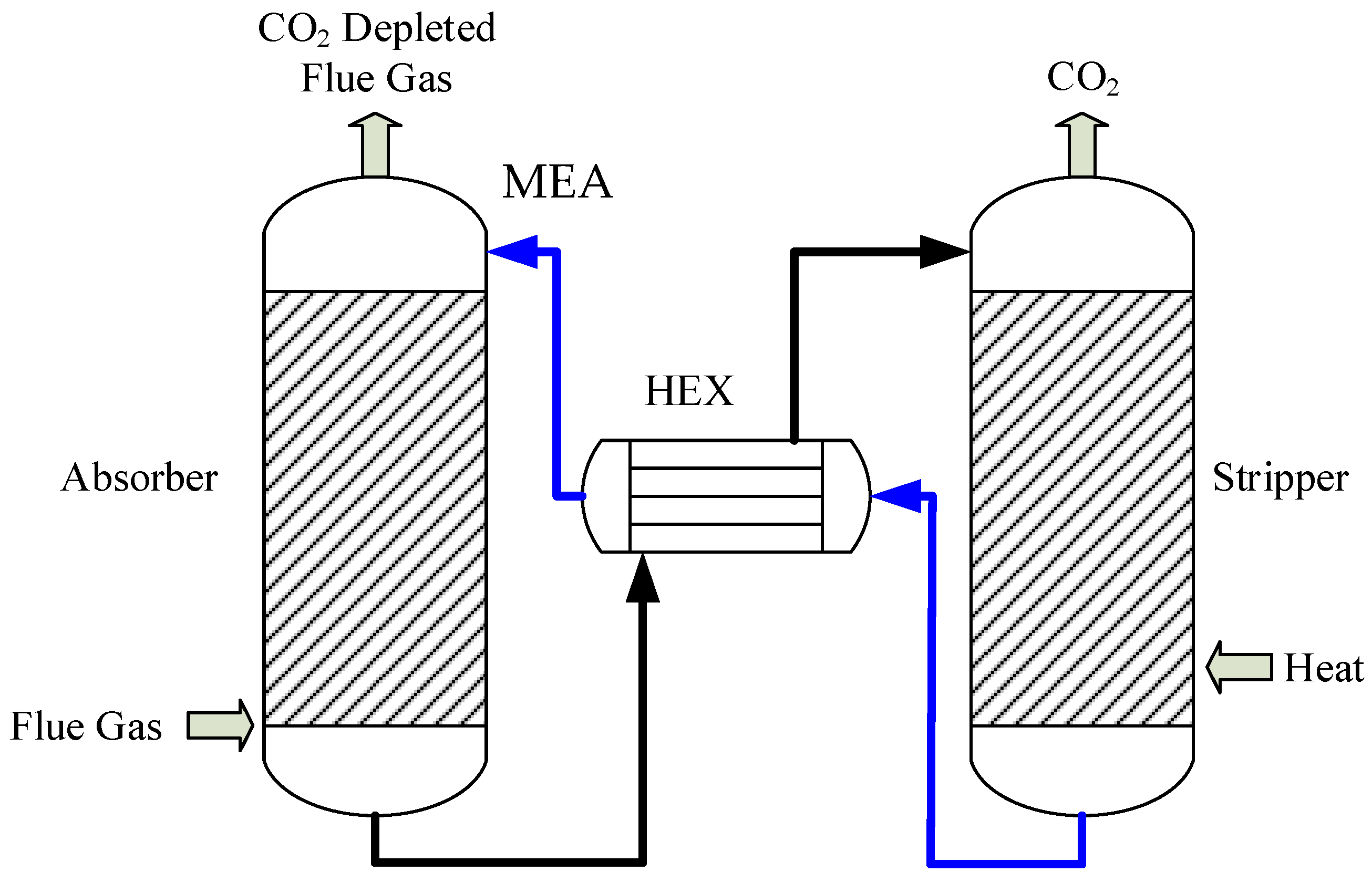
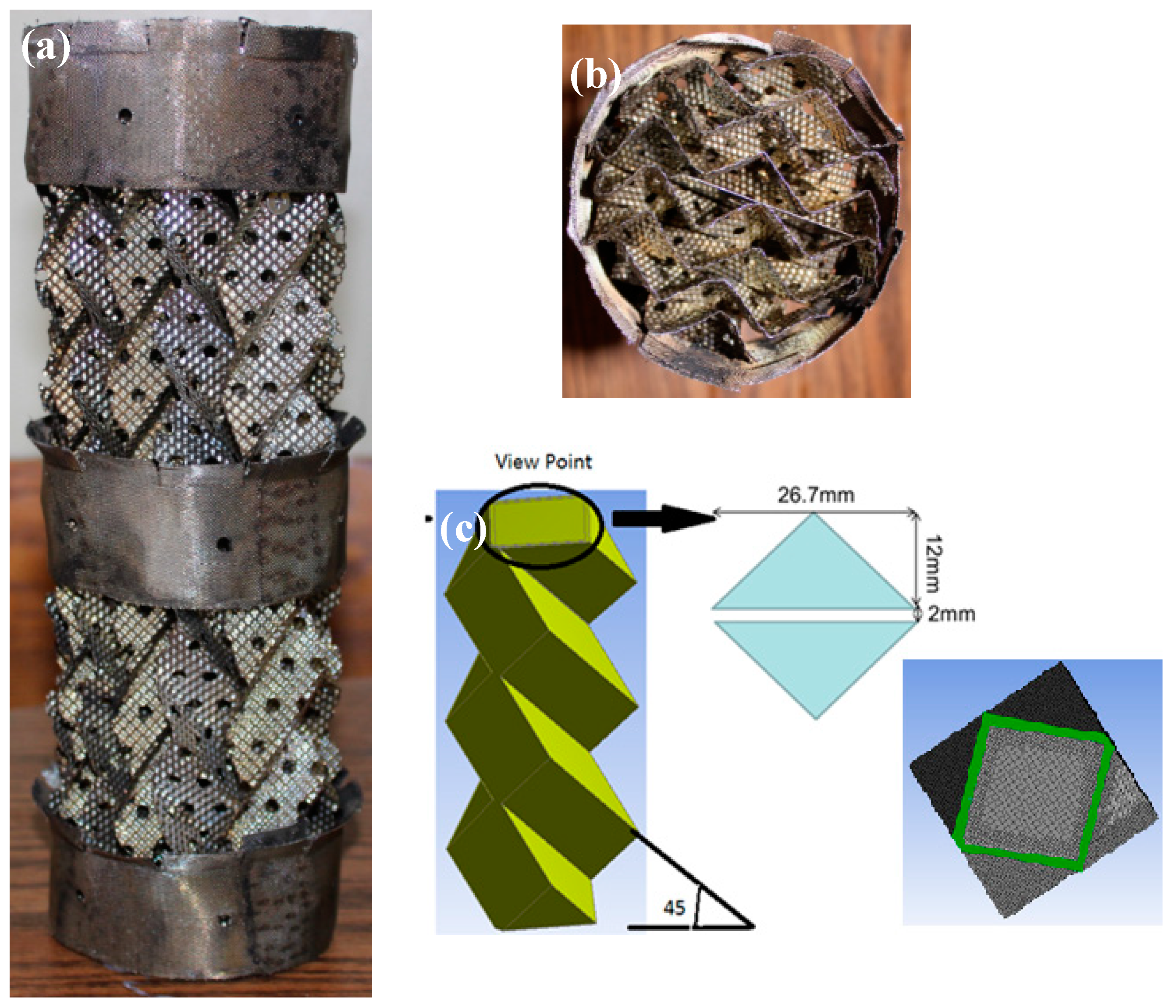
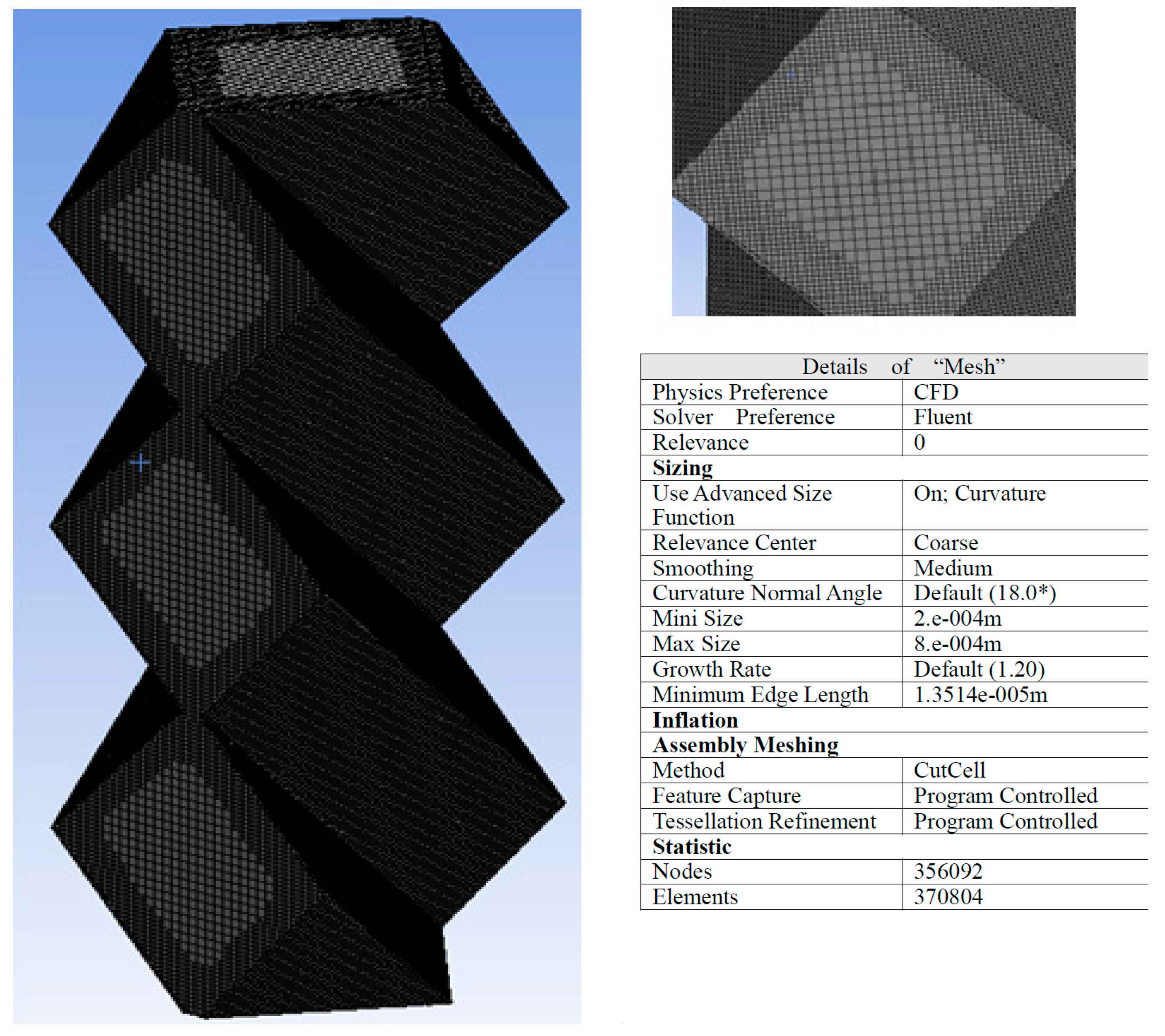
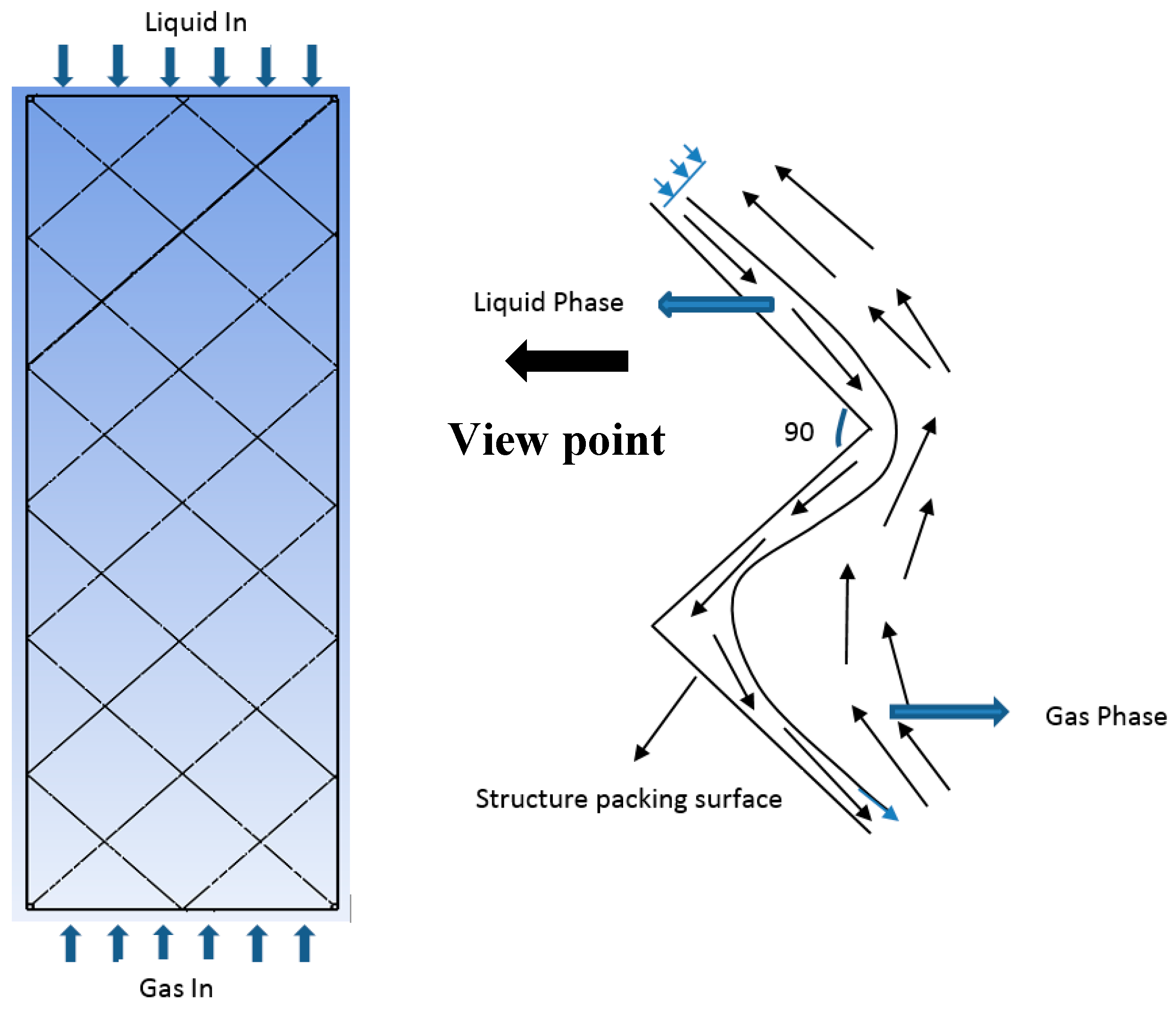
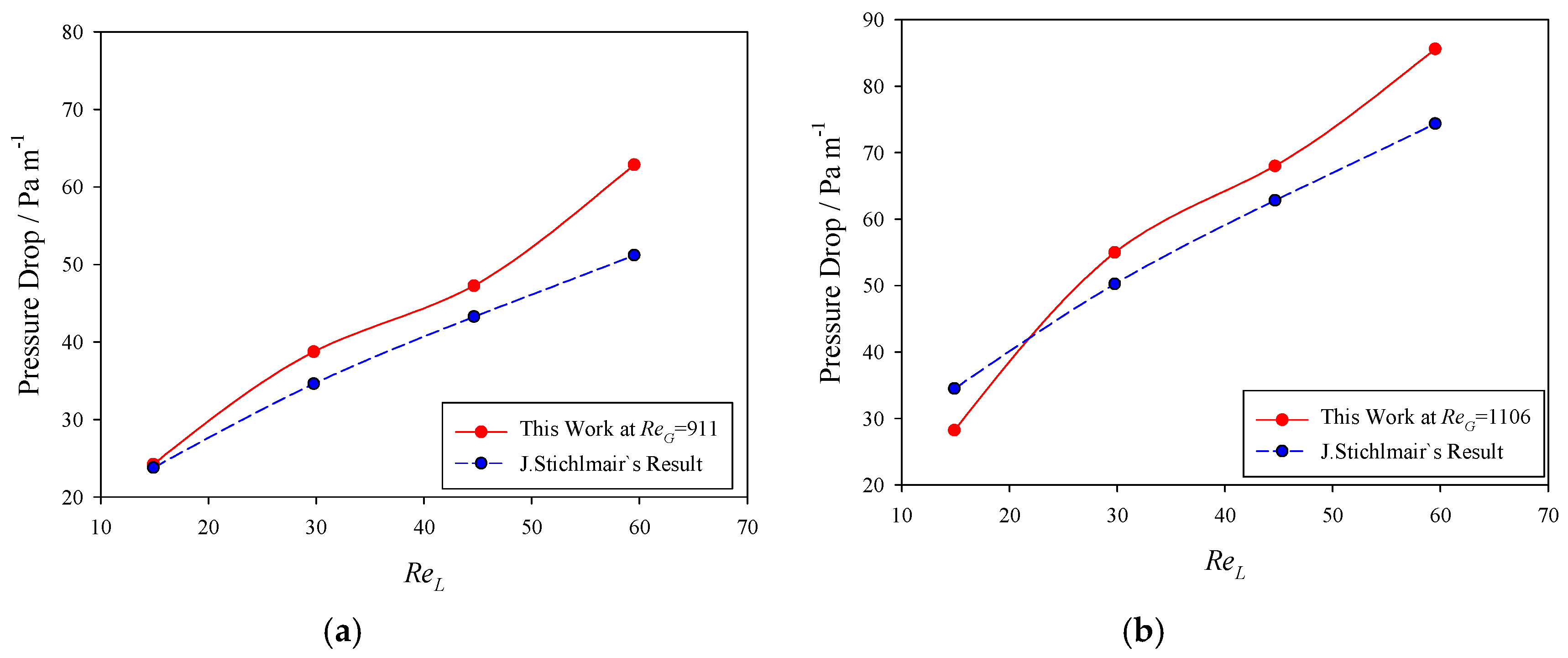
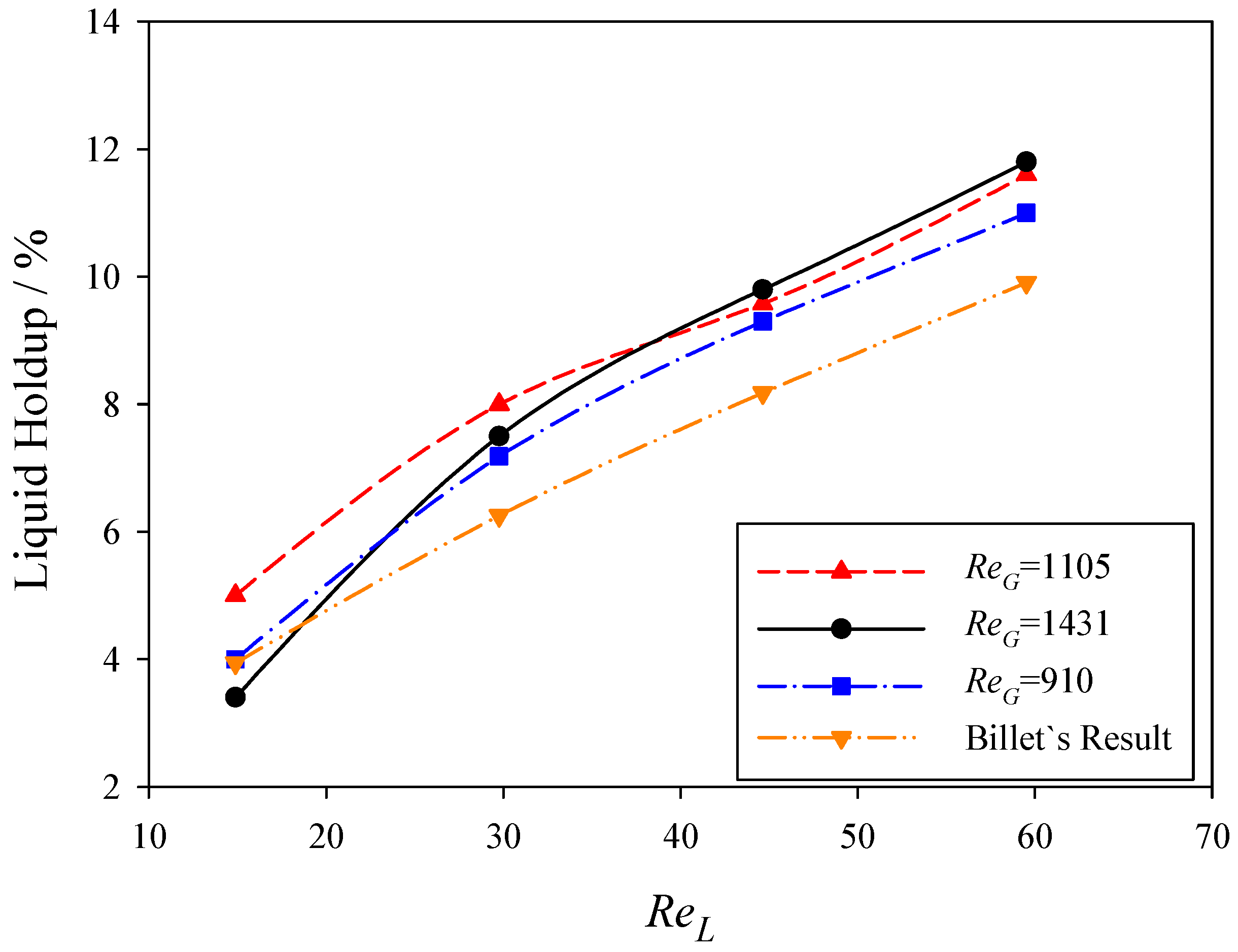
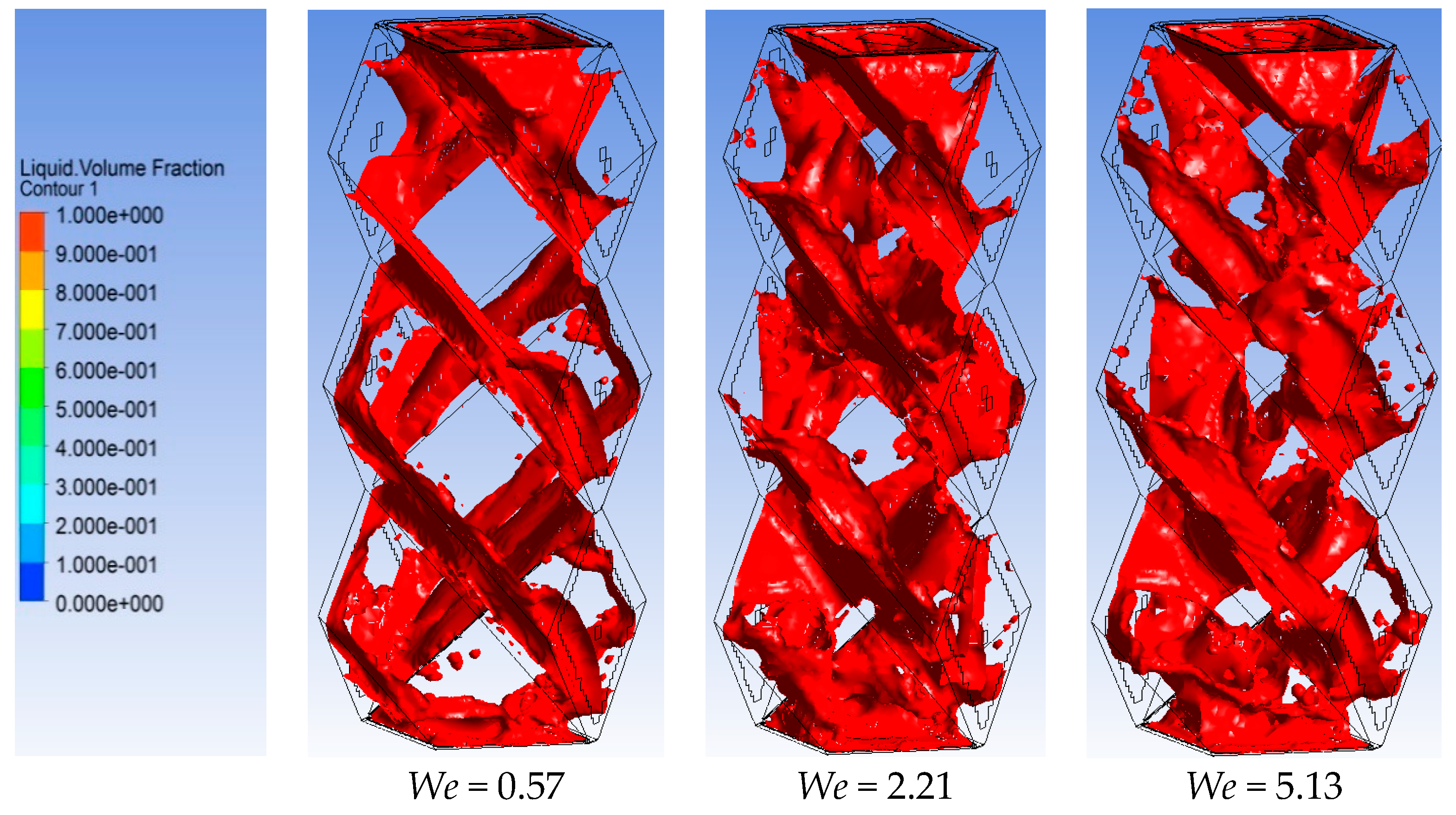
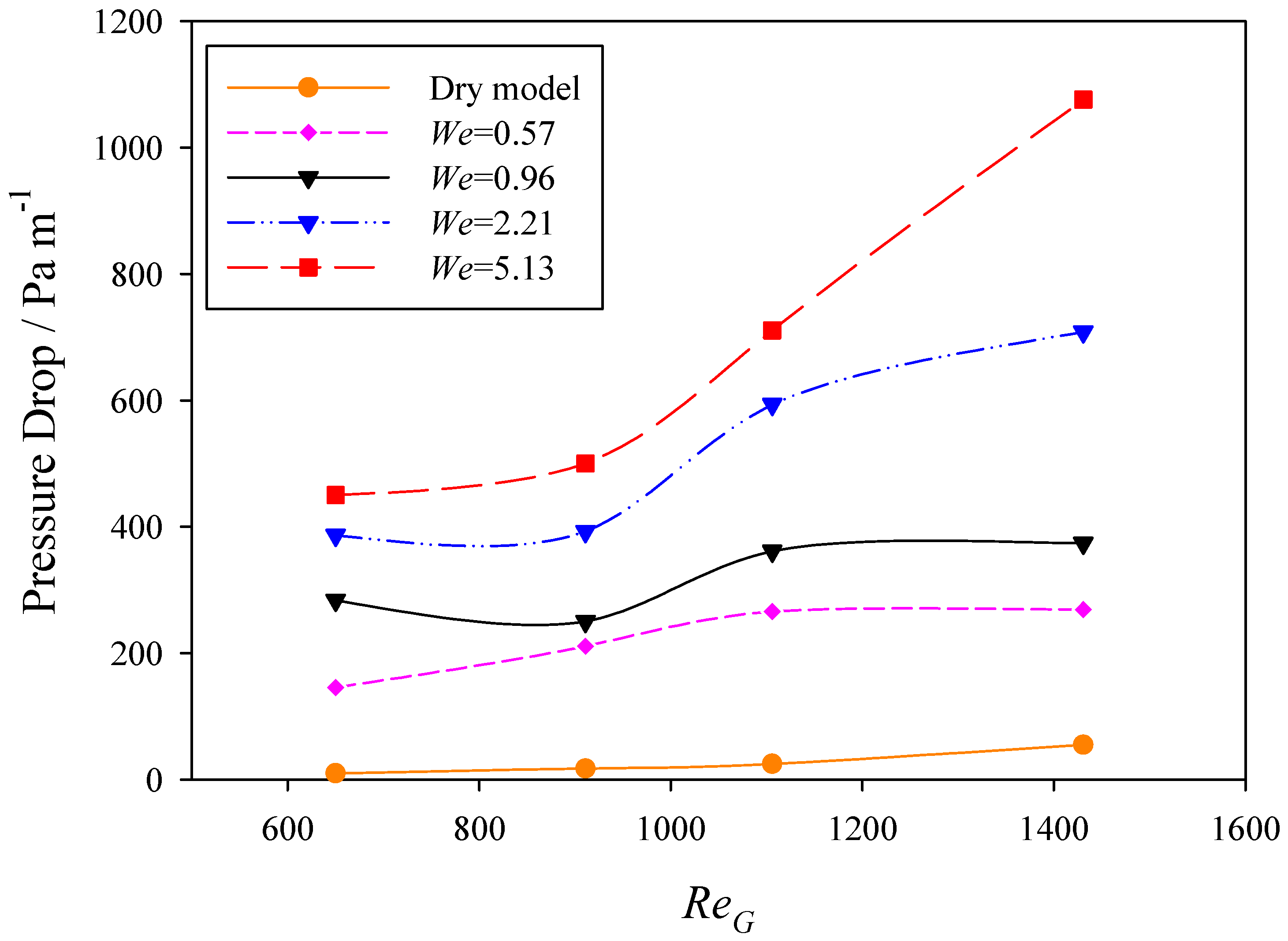

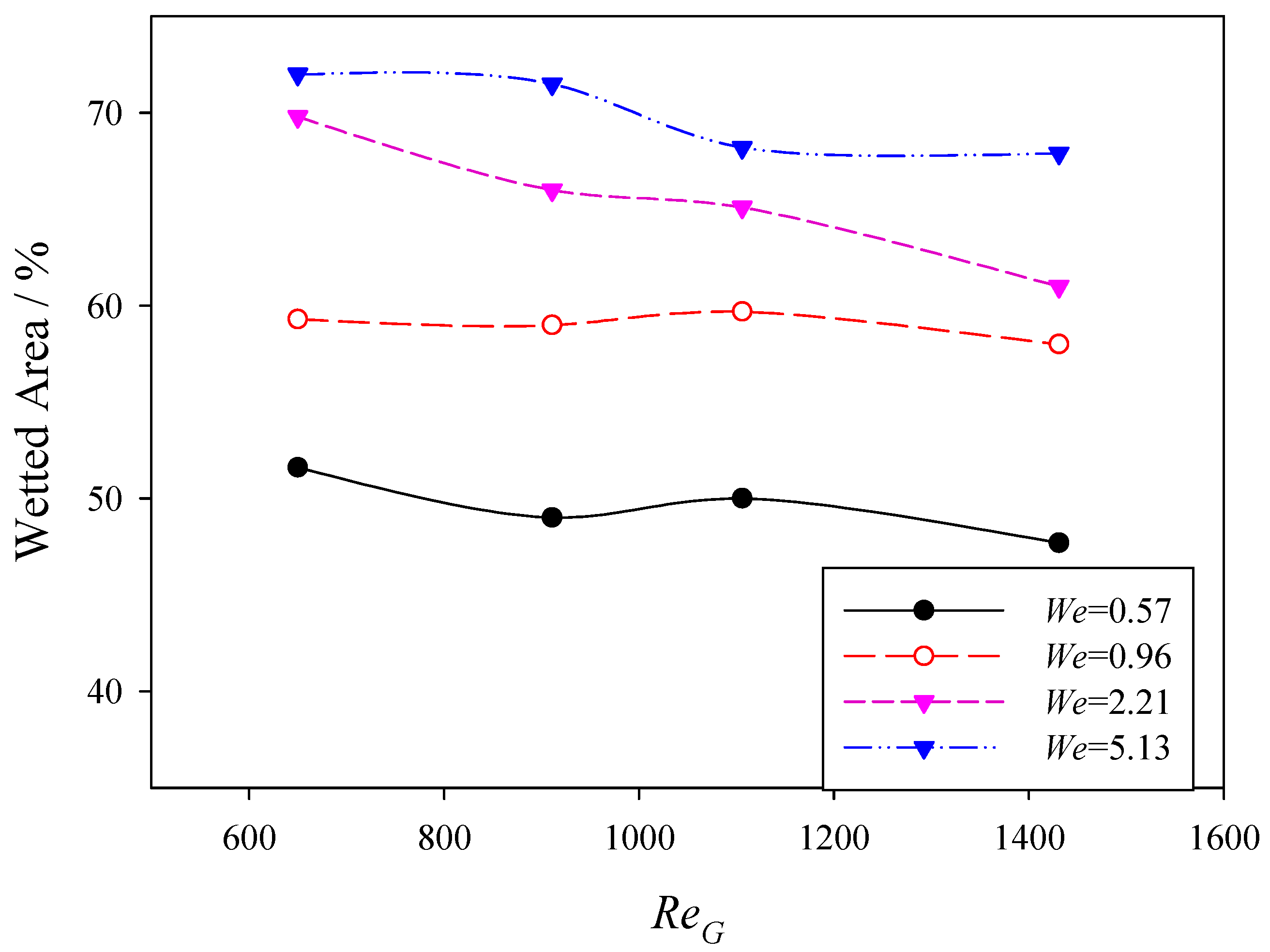
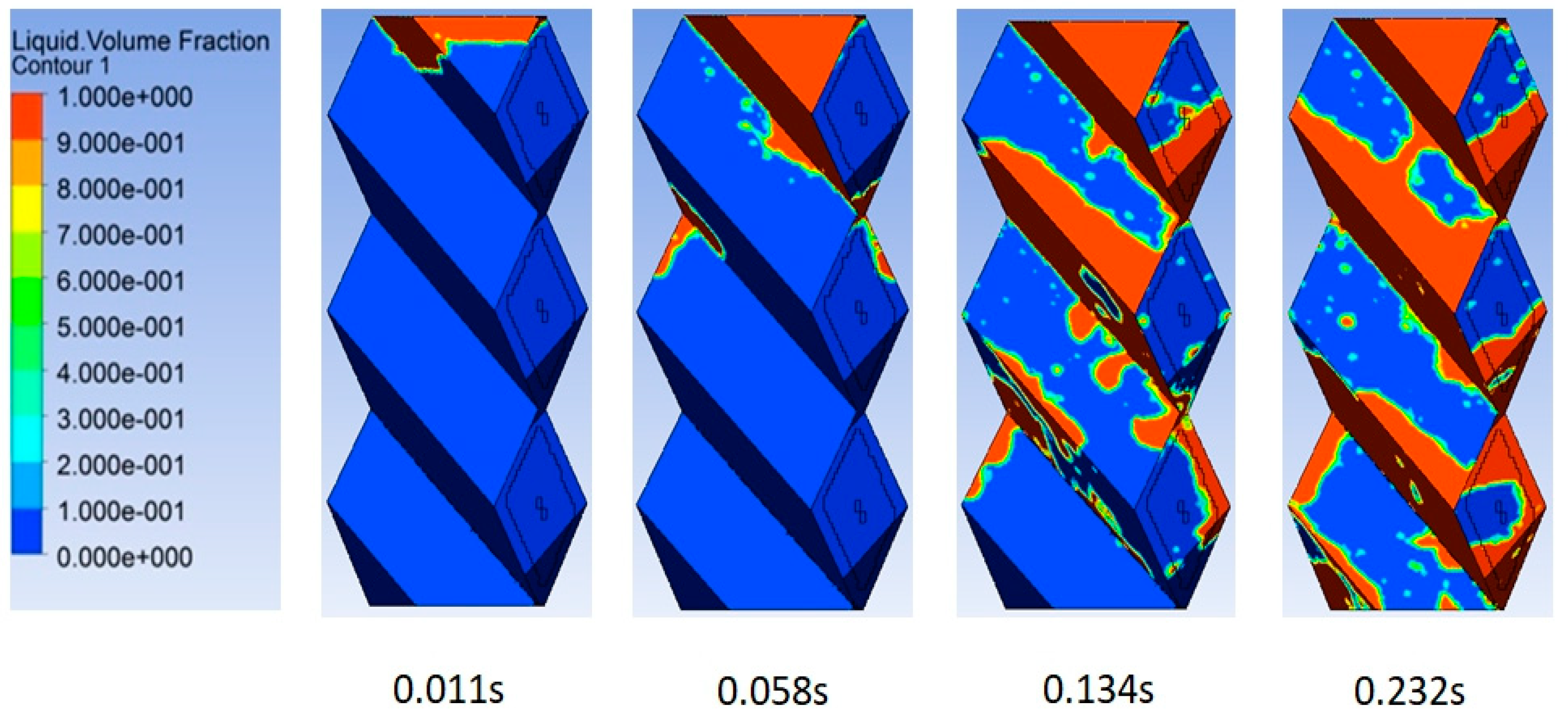
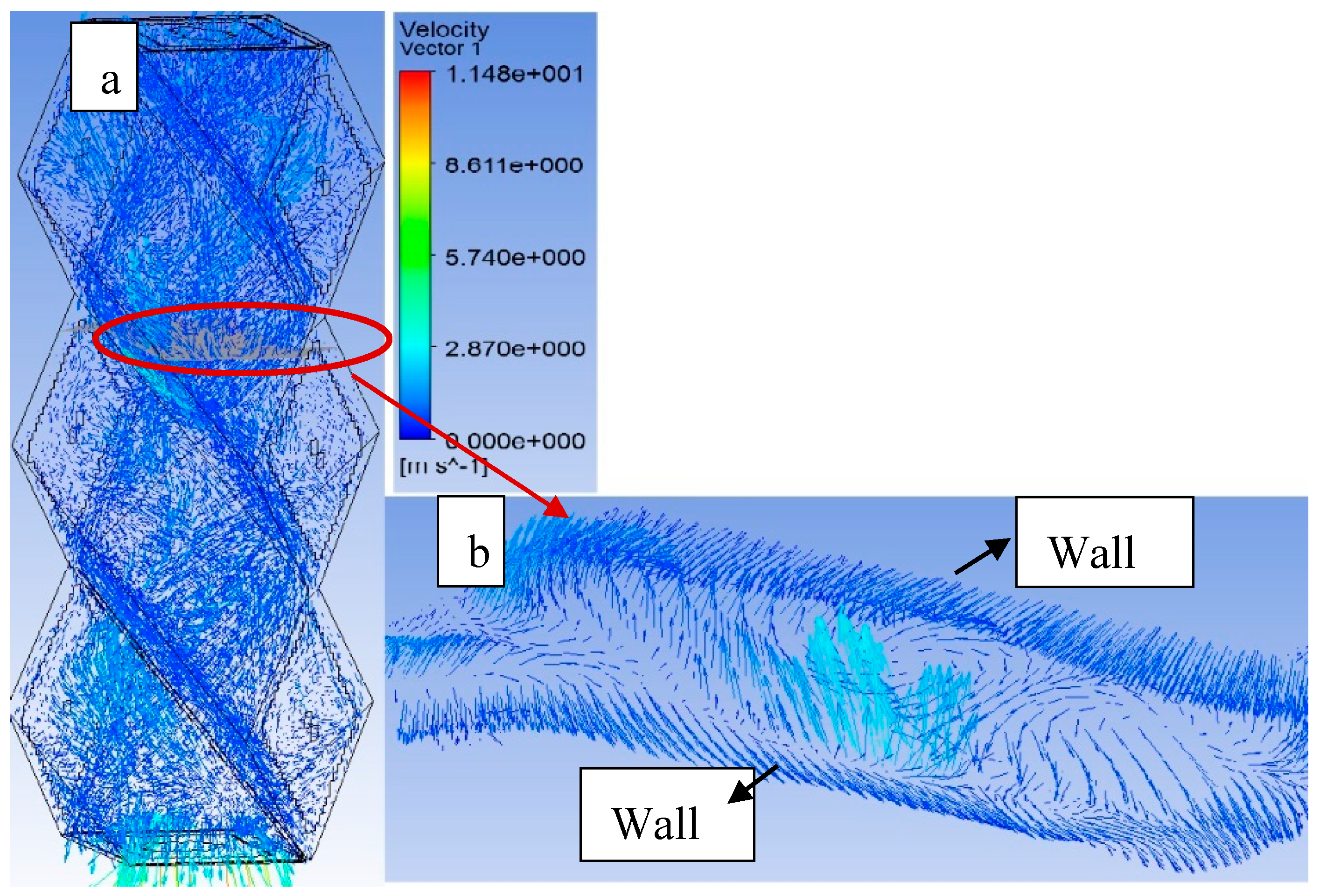
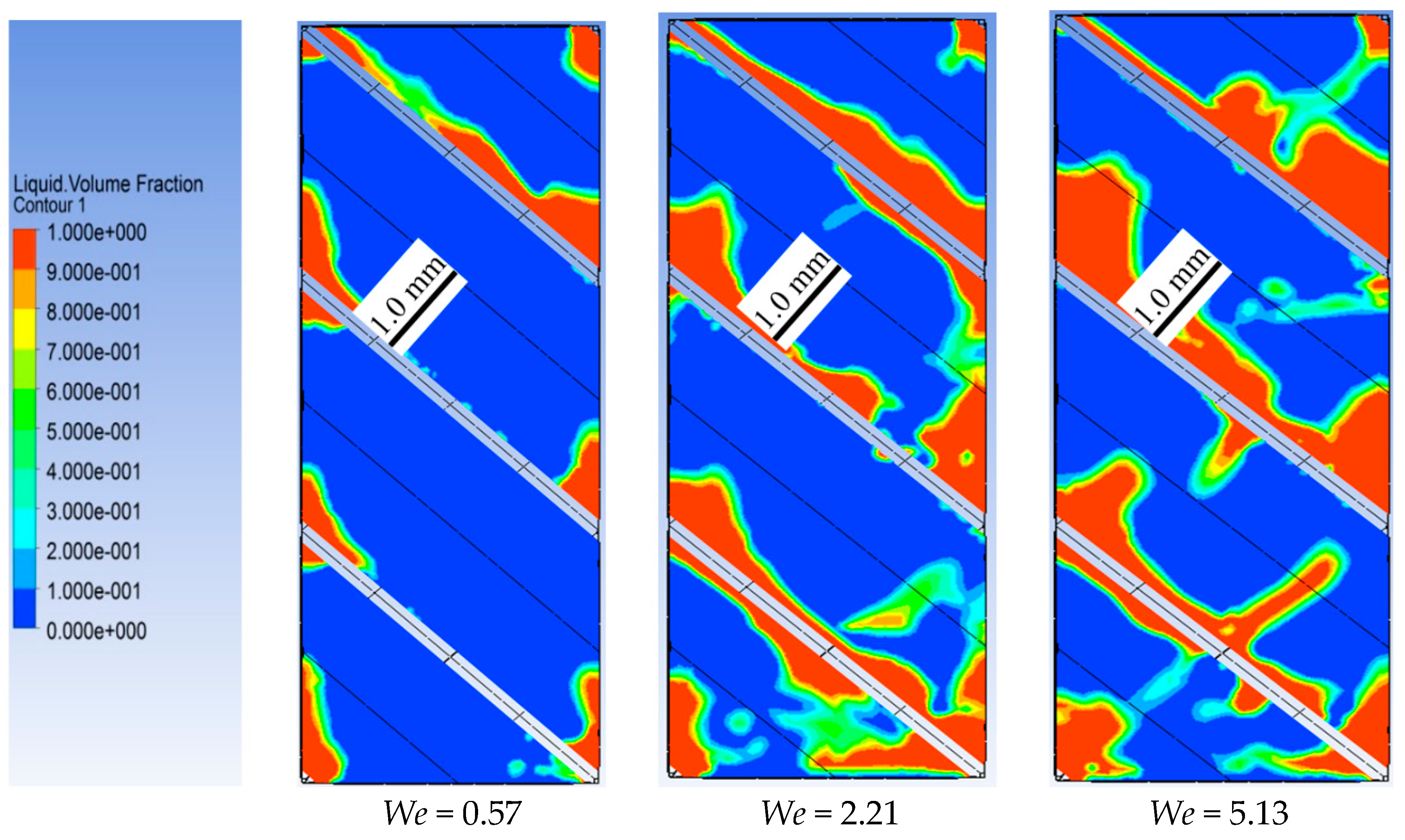
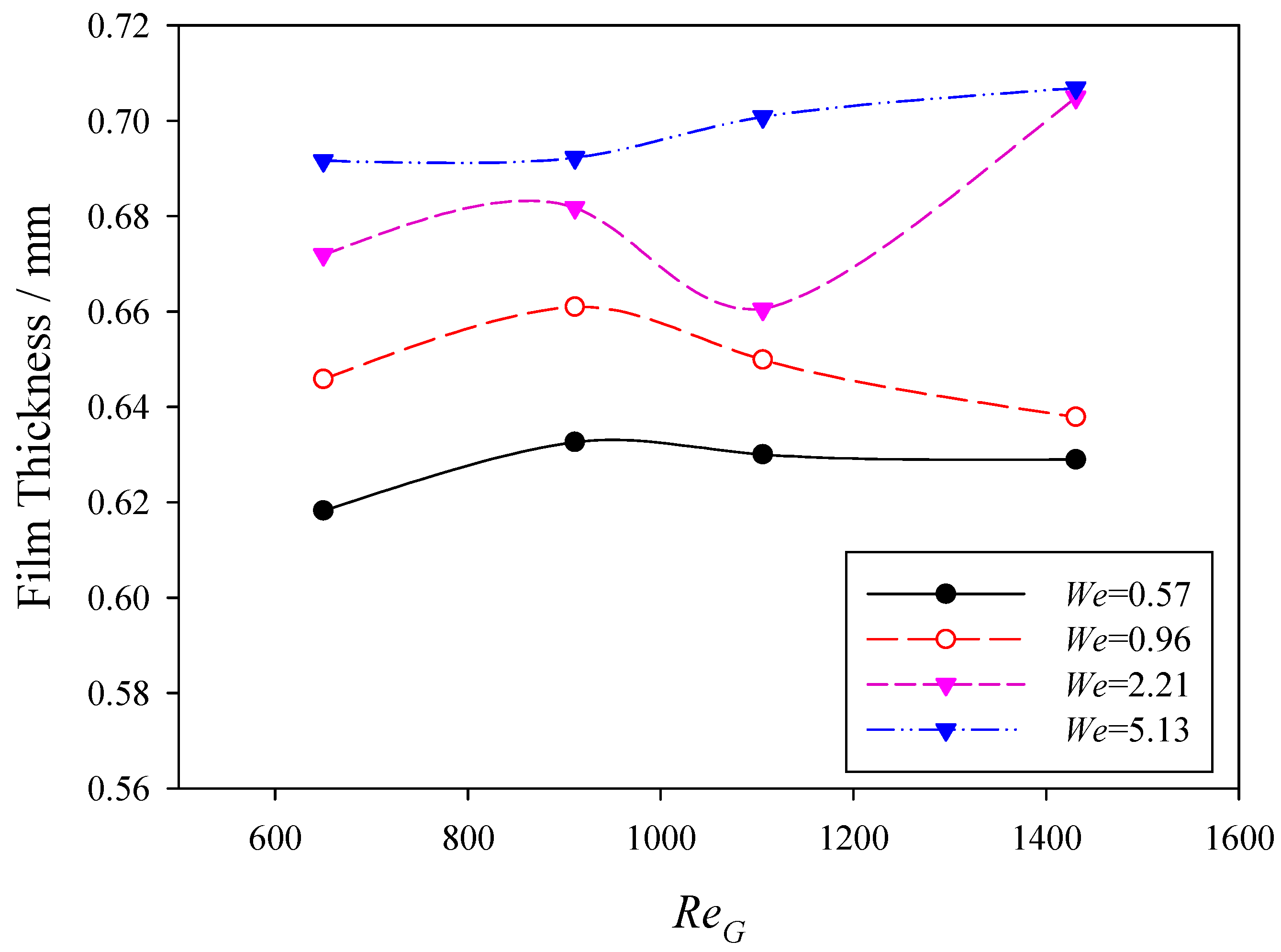
| Reference | Geometry Models | Contribution |
|---|---|---|
| Yu et al. (2018) [17] | 2D Structured and 3D Porous Model | From the 2D volume of fluid (VOF) model, the accumulation of the liquid in the troughs of the rough surface caused the average film thickness to be larger on the rough surface than on the smooth surface, particularly for low liquid loads. In the 3D VOF model, the flow paths were similar on the two surfaces, but the effective wetted area was slightly larger on the rough surface than on the smooth surface. |
| Olenberg et al. (2017) [18] | Montz B1-250 Structured Model | Built a single-phase CFD simulation model, and predicted the pressure drop in structured packings. |
| Haroun et al. (2014) [19] | 3-D Vertical Plate Model | Prediction of effective area and liquid hold-up in structured packings. |
| Ding et al. (2015) [20] | 3D Structured Model | Characterized the pressure drop trend. |
| Fourati et al. (2013) [21] | 1D Model | The Eulerian two-fluid framework with user-defined functions and associated models are taken into account in the liquid dispersion model. |
| Haroun et al. (2012) [22] | 2-D Structured Packing Model | Studied mass transfer and liquid hold-up in a 2D cross section structured packing using the VOF method. |
| Boundary | Materials | Type | Value | Velocity | Reynolds Number | Weber Number |
|---|---|---|---|---|---|---|
| Liquid inlet | Water | Mass Flow Rate | 12.2–48.8 m3/(m2·h) | 0.015–0.6 m/s | 15–600 | 0.02–5.13 |
| Gas inlet | Air | Velocity m/s | 0.5–1.1 m/s | 0.5–1.1 m/s | 325–1200 | - |
| Liquid outlet | - | Pressure-outlet | 0 Pa | - | - | - |
| Gas outlet | - | Pressure-outlet | 0 Pa | - | - | - |
© 2018 by the authors. Licensee MDPI, Basel, Switzerland. This article is an open access article distributed under the terms and conditions of the Creative Commons Attribution (CC BY) license (http://creativecommons.org/licenses/by/4.0/).
Share and Cite
Yang, L.; Liu, F.; Saito, K.; Liu, K. CFD Modeling on Hydrodynamic Characteristics of Multiphase Counter-Current Flow in a Structured Packed Bed for Post-Combustion CO2 Capture. Energies 2018, 11, 3103. https://doi.org/10.3390/en11113103
Yang L, Liu F, Saito K, Liu K. CFD Modeling on Hydrodynamic Characteristics of Multiphase Counter-Current Flow in a Structured Packed Bed for Post-Combustion CO2 Capture. Energies. 2018; 11(11):3103. https://doi.org/10.3390/en11113103
Chicago/Turabian StyleYang, Li, Fang Liu, Kozo Saito, and Kunlei Liu. 2018. "CFD Modeling on Hydrodynamic Characteristics of Multiphase Counter-Current Flow in a Structured Packed Bed for Post-Combustion CO2 Capture" Energies 11, no. 11: 3103. https://doi.org/10.3390/en11113103





